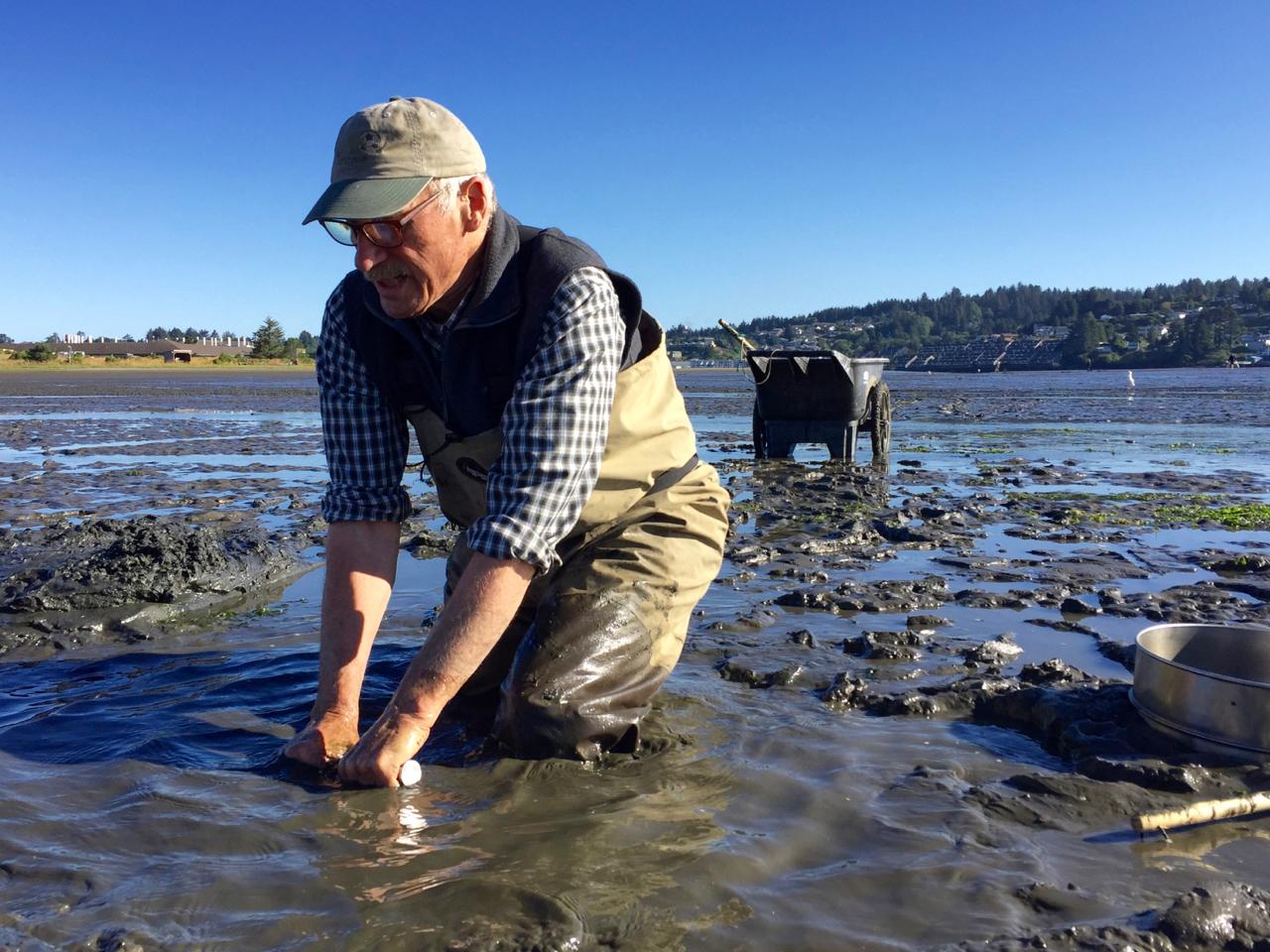
John Chapman uses a clam gun to suck mud shrimp out of their burrows in Newport's Yaquina Bay.
Cassandra Profita/OPB / EarthFix
Oregon State University researcher John Chapman is knee-deep in mud and sinking deeper by the minute. The mudflat surrounding him in Newport’s Yaquina Bay is pocked with holes – some snaking down more than 6 feet underground.
These are the burrows of the burrowing mud shrimp.
“This is the last, biggest population in the world," he said. "In San Francisco Bay, they’re extinct. In most of California, they’re extinct."
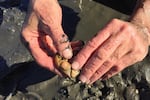
An invasive parasite from Asia attaches itself to mud shrimp native to the West Coast and prevents them from reproducing.
Cassandra Profita/OPB / EarthFIx
He plunges a clam gun into the pool of water surrounding him and pulls up a shrimp about the length of his palm. It has a large bulge on one side – about the size of a cough drop.
He lifts up the side of the shrimp to reveal a white centipede-looking creature nestled inside.
“That’s the isopod," he said. "That’s like having a parasite the size of a mid-size cat or dog under your armpit sucking blood out of you. You probably would notice.”
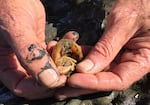
A parasitic isopod with white legs under the shell of a mud shrimp.
Cassandra Profita/OPB / EarthFix
Mud shrimp are native to the West Coast. They used to be common from California to Alaska. But now when Chapman goes looking for them they're either gone or infested with this parasite, which came from Asia – likely in a ship's ballast water.
For years, oyster growers in the Northwest have been looking for ways to kill the burrowing mud shrimp. Now, it seems, this invasive parasite is doing it for them by preventing the shrimp from reproducing.
“So far all the things we’ve tried suggest that this really is on a trajectory of extinction," Chapman said. "There are no populations that have escaped this parasite. Every place we’ve looked for this parasite in this host, it’s there.”
'The end of the world'

The dimples in the mud in Yaquina Bay at low tide are the burrows of burrowing mud shrimp.
Cassandra Profita/OPB / EarthFix
Looking out at the dimpled Yaquina Bay mudflat, Chapman says, is like looking out over the rooftops of New York City.
"All the action is going on underneath," he said.
The network of shrimp burrows under the mud is like a subterranean metropolis.
"Close your eyes and think of a coral reef that's two meters high that's not there – it's underneath," he said. "We're looking at a thing that extends down into the dark instead of up into the light like a coral reef."
In addition to being a food source for fish like sturgeon, he said, mud shrimp create a unique habitat under the surface of the mud for more than a dozen different species.
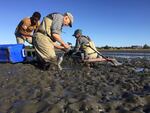
Researchers collect mud shrimp from Yaquina Bay for a study that will keep them alive to measure how fast an invasive parasite is slowing their growth.
Cassandra Profita/OPB / EarthFix
"These shrimp build a city only certain species can live in," he said. "They can't survive without the mud shrimp, so for them it's the end of the world when this shrimp is gone. To lose them would be like losing a forest."
At the same time, he says he knows it's "a poor life choice" to spend his time trying to save a shrimp that oyster growers consider a pest.
"People love to eat oysters," he said. "This thing is bad for oysters, so why is this guy trying to save something the oyster growers hate? Well, the shrimp are native, and the oysters are not."
To save these shrimp, Chapman says what he really needs is more research, and he's found a surprising ally on that front: a scientist who was hired to help commercial oyster growers kill the shrimp.
Kill the shrimp – or save them?
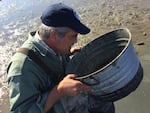
Brett Dumbauld checks a sieve for mud shrimp babies.
Cassandra Profita/OPB / EarthFix
Brett Dumbauld is staring into a sieve dotted with baby mud shrimp in Oregon’s Tillamook Bay.
"Cute little buggers aren’t they?" he says.
As an ecologist with the U.S. Department of Agriculture, Dumbauld's job is to study ways to kill mud shrimp for commercial oyster growers. Their farmed oysters were introduced from Japan. When the native shrimp dig their holes, these oysters, which didn't evolve in the same ecosystem, often slip into the mud and suffocate.
For years, the growers sprayed a pesticide called carbaryl on their beds to kill the shrimp.
"But then they've been up against concern from agencies and the general populace and their customers – all that kind of stuff," Dumbauld said.
After a lawsuit, the growers agreed to stop using carbaryl in 2012.
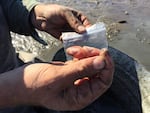
A baby mud shrimp small enough to rest on the tip of a finger.
Cassandra Profita/OPB / EarthFix
"We were trying to think of alternatives," Dumbauld said. "That was the big deal: Can we find something else that will work?"
So, Dumbauld has researched alternative pesticides the growers can use to kill the shrimp and other methods that might work – like tilling the mud flats with machinery or zapping them with electricity.
Part of his job is to keep tabs on how the shrimp population is doing – by counting the both the adults and the babies, or recruits.
"Those recruits matter," he said. "The more recruits you have, not surprisingly, the more adults you have."

Brett Dumbauld stands on top of a metal ring to sink it into the mud in Oregon's Tillamook Bay. The group will dig out the contents and sort through them by hand to count the shrimp inside.
Cassandra Profita/OPB / EarthFix
Dumbauld was the first to notice when the mud shrimp started getting the parasite back in 1988. He kept a log over the years and watched as the parasite numbers in Washington’s Willapa Bay shot up while the shrimp numbers plummeted.
“At that point we were like, ‘Oh, that’s interesting. The shrimp started to decline and the isopod was increasing. What’s going on?” he said.
Since then, the shrimp have all but disappeared from Washington's Willapa Bay, Grays Harbor and Puget Sound.
“So, they’re clearly not causing a problem for the growers up there anymore,” he said. "They definitely have disappeared from the places where they used to be."
Teaming up
Chapman says Dumbauld’s research is critical to saving the shrimp from being wiped out altogether.
“His data is some of the most important data we have for understanding the entire problem," Chapman said. "If he wasn’t doing that, then we would be far behind where we are now.”
The way he sees it, they both share the goal of managing the mud shrimp population. And nobody wants to see the species go away altogether.

Brett Dumbauld counts shrimp in Oregon's Tillamook Bay with a team of researchers.
Cassandra Profita/OPB / EarthFix
"Even though his mandate is to kill the shrimp, that means manage the shrimp," Chapman said. "And my mandate is to save the shrimp, and that also means manage the shrimp. So, there's this compromise in between."
Dumbauld says he finds it interesting that the mud shrimp populations are declining, and he wants to learn more about it. So, he has teamed up with Chapman to publish several studies. But that doesn't mean the scientist hired to help kill shrimp now wants to protect them.
“I try not to take a position on that as a scientist," Dumbauld said. "I'm neither trying to kill them or – I mean, in a way I'm trying to enable the growers to get rid of them on their oyster beds.”
Dumbauld continues to study ways to kill ghost shrimp – another native burrowing shrimp whose population is growing and causing problems for oyster growers.
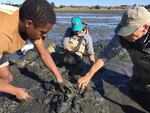
John Chapman digs through the mud to find mud shrimp for their latest study.
Cassandra Profita/OPB / EarthFix
But he and Chapman both recognize that having mud shrimp on the endangered species list wouldn’t be good for oyster growers, either. And at the rate the shrimp are disappearing that is a possibility.
When an imperiled species is "listed" under the ESA, protections are usually enforced and that could be a big problem for oyster farms.
“If this were an eagle, it would be on the list," Chapman said. "It would make it easily, but we don’t want to do that. What we’d like to do is solve the problem before we’re there.”
So, the two scientists are working together. Their latest study involves collecting healthy and infected shrimp and keeping them alive to study how much the parasite slows their growth. That will give them an idea of how fast the shrimp are collapsing – and how much time is left to save them.
